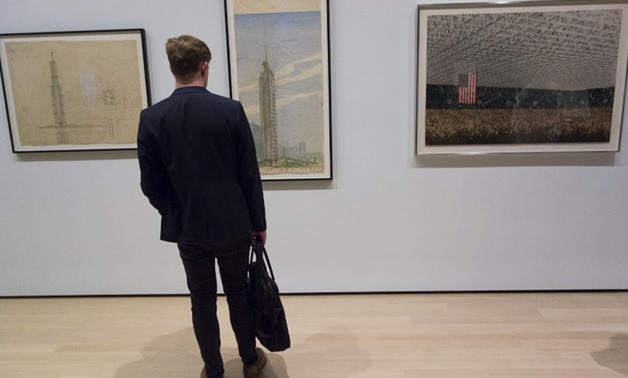
Journalists get a look at the "Frank Lloyd Wright at 150: Unpacking The Archive" exhibit during a media preview at the Museum of Modern Art in New York – AFP/Don Emmert
NEW YORK – 12 June 2017: From a skyscraper twice the height of today's tallest building to self-sufficient farms designed to offset the Great Depression, a New York exhibition is spotlighting the hidden projects and dreams of Frank Lloyd Wright.
"Unpacking the Archive" is the product of painstaking research from thousands of documents that lay dormant in the personal archive of Wright, that most famous and revered of US architects, 150 years after his birth.
Opening at the Museum of Modern Art on Monday and running until October 1, it offers a new glimpse into Wright, five years after the institution, together with Columbia University, acquired the legend's archives.
"He has been the most exhibited and lionized architect in the museum's history," says curator Barry Bergdoll. "Probably the only architect that is almost more popular with the general public than with the architect community."
To that end the museum invited a dozen architecture historians to "come and play" with the archives and come up with a compelling exhibit, he explains.
Spread across 13 rooms, the exhibition explores little-known aspects of the work and personality of the architect, born in 1867 on the prairies of Wisconsin and whose career spanned seven decades until his death in Arizona in 1959.
If he is best known for the Guggenheim in New York or "organic architecture" such as his 1930s "Fallingwater" house built over a stream in Pennsylvania -- only half of the 1,000 projects he conceived ever materialized.
But Wright kept everything: different versions, some of them annotated, designs that were themselves revolutions in graphics, ultra-detailed models, photos of himself at work, rejection letters and newspaper clippings.
Even when his projects were rejected, that did not stop him shopping them around with an innate sense of marketing.
One of them was "Little Farms," dreamt up in the early 1930s to create self-sufficiency for workers laid off during the Great Depression, and which would allow urban communities to buy fresh products in nearby markets.
The project never saw the light of day, but Wright promoted it until his death, even traveling to the Soviet Union in 1937, at the height of the Stalin purges, to visit collectives and attend an architecture congress in Moscow.
Another fantasy was the "Mile-High Illinois" -- a 1.6 kilometer high skyscraper -- which Wright unveiled at a press conference in Chicago in October 1956 at the age of 89, two and a half years before his death.
On one blueprint he wrote that it could house 100,000 people over six million square feet (550,000 square meters) with 15,000 parking spaces and 100 spots to park helicopters.
With an eye on history, he referenced the ancient Egyptian pyramids in one design. Sixty years later, the highest building in the world, the Burj Khalifa in Dubai, is only half as tall at 828 meters (2,716.5 feet).
Several of the top floors of Wright's huge tower would have been dedicated to television operations. While a fierce critic of US society, he understood the potential of the medium early and never lost a chance to grace the small screen.
The exhibition includes footage from his appearance as a guest on the "What's My Line?" game show in 1956, in which blindfolded contestants had to guess Wright's identity. When one finally pipes up "world-famous architect," Wright beams.
"If Wright were here today, he'd be everywhere on social media," said Bergdoll.
"He would understand the relationship of new technology to fame, to getting your message out, and keeping yourself in the public eye," he said.
"The fact that he was able to do that when he was in his 80s, in a very persistent and even charming way, is pretty impressive," he added.


Comments
Leave a Comment